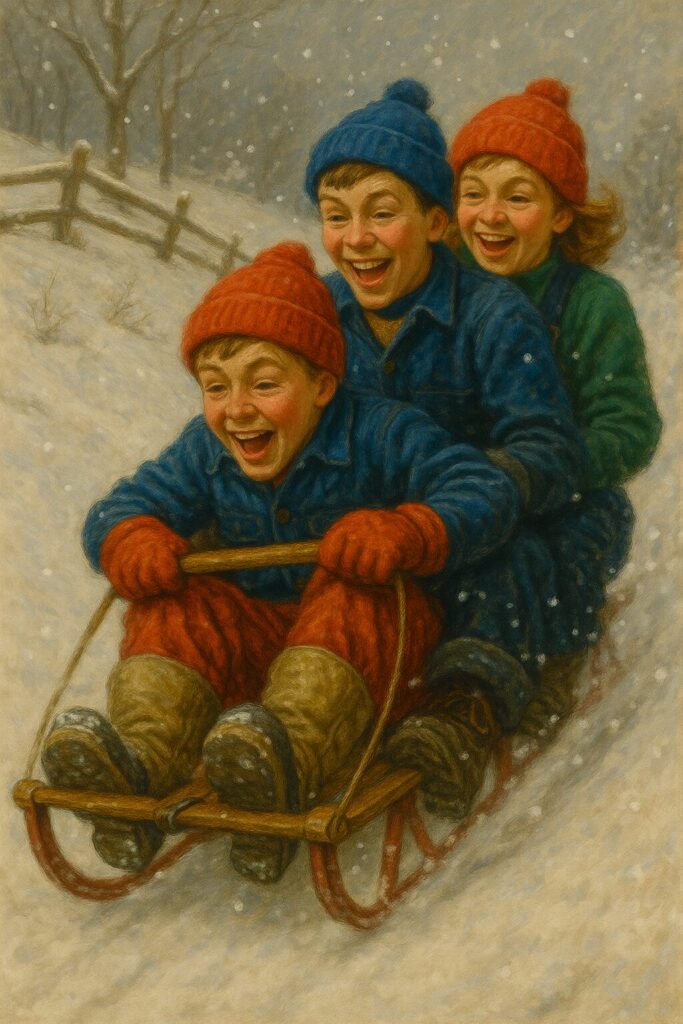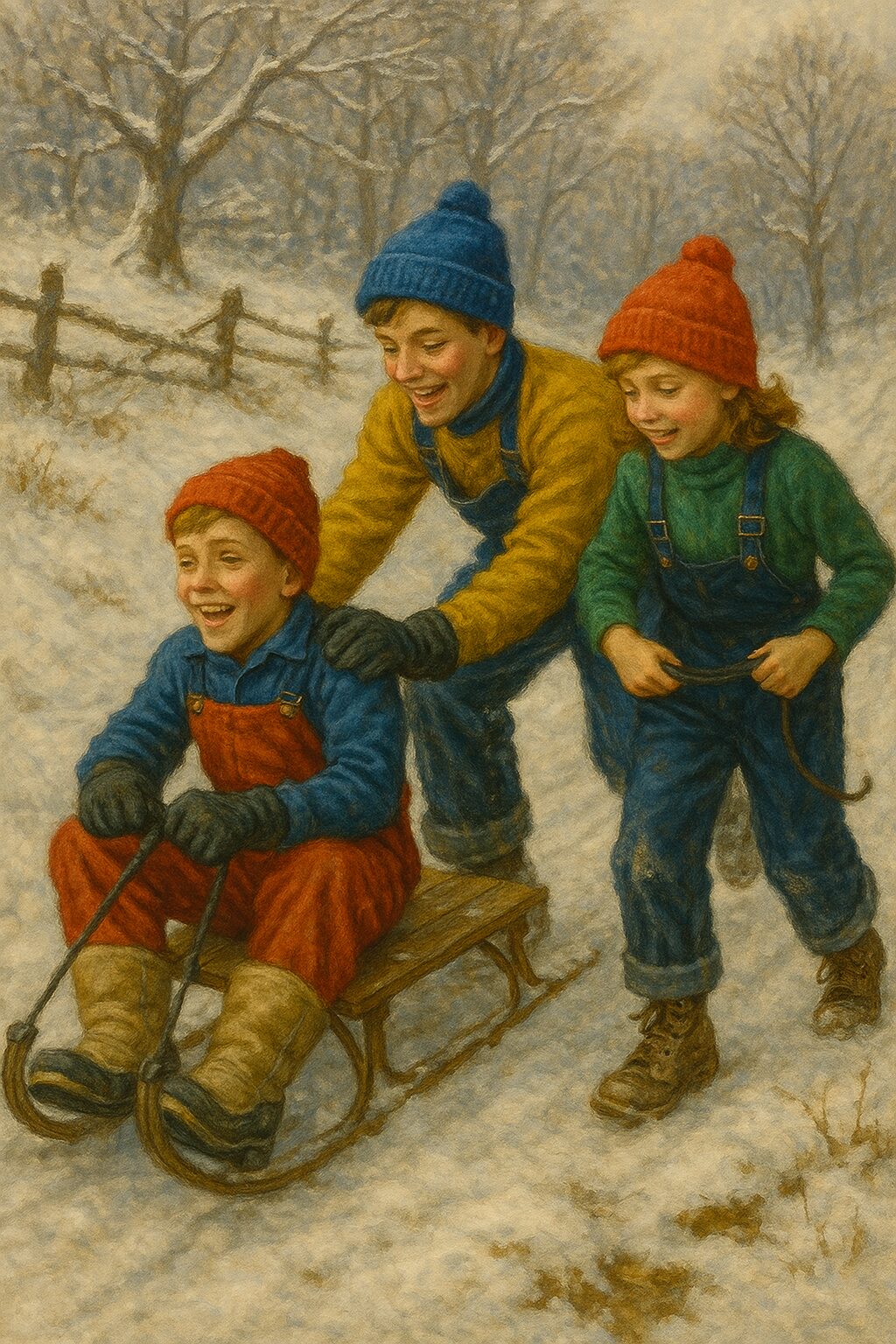Before Christmas each year, long before the first flake fell, my brother and I would start whispering about the snow—the one that would finally shut down school. Not the little dustings that melted by lunchtime, but the Big Winter Snow. In East Tennessee, you could count on one good snowfall each year, maybe two if the weather gods were generous. It might last a few days. A full week if fortune smiled. That was the dream.
The Ritual of Readiness
The preparations began early. My mother would drive my brother and me to look for new ski bibs—those nylon suits with suspenders that made us feel like professionals. I do not remember when we discovered them, only that once we did, we could never go back. Each winter we had outgrown last year’s pair, so new ones were as essential as school supplies in August.

The bibs were genius. You could wear almost anything underneath them—layers of flannel, jeans, even pajamas—and still be ready to charge into the cold. They were the firefighter gear of our small suburban battalion. When the call came, we could leap into action, pulling on our bibs and boots in seconds.
We also had waterproof gloves—vital for anyone planning to survive a day in snow combat—and a trusty knit toboggan to keep our heads warm. The gloves were the difference between glory and retreat, and we guarded them jealously. One lost glove could end a mission.
The final piece of the uniform was the pair of “moon boots,” those bulbous, space-age relics of 1980s winter fashion. We looked like astronauts preparing to explore the Arctic frontier of our backyard. We would stomp around the house in them, pretending to test the grip on imaginary ice.
The Waiting Game
Winter in the 1980s brought an element of mystery. Weather forecasts were closer to rumor than science. Most local meteorologists seemed destined for later careers in comedy—an ironic reflection on their accuracy. Each night, my brother and I would huddle near the TV, waiting for the evening forecast from Knoxville, ninety miles west. “A strong chance of accumulation in the higher elevations,” they would say. That was the magic phrase. “Accumulation” meant the difference between algebra and adventure.
We would go to bed late, pushing off homework as long as possible, hoping to hear the silence of snow—the muffled stillness that comes only when the world is covered in white. Sometimes, Mom would peek into our room and shake her head.
“Don’t get your hopes up, boys. They’ve been wrong before.”
“They said accumulation,” my brother would insist, as if the word itself could summon the storm.
And then, one night, it came.
The Call to Arms
The first clue was the light. You could always tell by the light. Even before opening the blinds, the world had a bluish glow, soft and bright at the same time. We would leap from our beds and press our faces to the window. The world had transformed overnight. Cars were buried to their wheel wells, and every roof wore a thick white hat.
“Mom! School’s out!” we shouted, though we had not yet confirmed it. Moments later, the radio did the honors: “All Kingsport City and Sullivan County Schools are closed.” The words rang like a national holiday.
Breakfast became a hurried formality—Pop Tarts inhaled between pulling on socks and snow pants. “Slow down,” Mom would say, laughing, but she knew better than to try to stop us. Within minutes we were outside, joined by a ragtag battalion of neighborhood kids, all converging on our destination: Suicide Hill.

Grooming the Mountain
The hill’s official name was Shady Side, a modest road that curved down the back of a small mountain. But middle-school boys rename the world as they see fit, and to us it was Suicide Hill. The legend went that years earlier a kid had sledded too far, too fast, and met some tragic fate on the sharp drop-off. Whether true or not, the name gave the place its power.
Our sleds were bright plastic boats, cheap and light—perfect for grooming the snow. Grooming was our ritual. Before the real runs began, we would spend hours sliding down again and again, packing the fresh snow into a hard base. “You’ve got to lay down a track,” my brother said, echoing wisdom he must have invented that morning. The goal was to prepare the hill for the night, when the temperature would drop and the packed snow would freeze into a glassy run of ice.
We would take turns shouting encouragement and commentary.
“Stay left of the tree!”
“Watch the ditch!”
“Go, go, go!”
Each run ended with a crash of laughter, a spray of snow, and the ceremonial hike back to the top.
By mid-afternoon we were soaked and exhausted. We trudged home, peeling off our bibs at the door like racecar drivers exiting their cockpits. The kitchen was warm and fogged with soup steam–Spaghetti O’s! Mom had our favorite soup and grilled cheese ready, as if she had been expecting an entire sledding army. We sat by the heater, thawing our fingers and plotting the night assault.
The Night Run
After dinner, the true event began. The older kids—high school legends we both admired and feared—appeared at the top of the hill. They brought metal runner sleds, the sleek Formula 1 machines of the sledding world. We had our own, though smaller and dented, inherited from uncles and garage sales.
A barrel fire burned at the top, surrounded by those big kids in denim jackets and ski caps. There was a smell I did not recognize then but would later understand—a blend of smoke, beer, and something else sweet and earthy. The older boys were loud, laughing and daring each other to go faster, to try the steepest line near the drop-off.
We stayed on the safer side, pretending not to watch them, but we all knew they were the heroes of this frozen battlefield.
“Ready?” my brother asked.
“Let’s go.”
We crouched on our sleds, the metal runners gleaming under the barrel’s flickering light. Someone shouted, “Three, two, one!” and we pushed off. The first rush of wind hit like a shock, freezing our breath. The sled rattled over the ice, faster and faster, until the trees blurred into streaks of black and white. The road curved sharply, and for a moment, the world tilted sideways. Then the hill leveled, and we coasted to a stop in the valley below, hearts pounding.
“Did you see that?” my brother shouted, breathless.
“Fastest one yet,” I said.
“Tomorrow, we’ll beat it.”
We hiked back up, our boots crunching the snow that glowed faintly in the moonlight. Above us, the stars were sharp and cold, like pinholes in the night.
The Afterglow
We sledded until our legs trembled and our gloves froze stiff. By the time we stumbled home, it was near midnight. Mom met us at the door with towels and hot chocolate. The ritual repeated itself: peel off the bibs, hang the gloves near the vent, devour dinner leftovers, and collapse into bed.
For the next several days, as long as the snow lasted, we returned to Suicide Hill. Each morning the track was icier, faster, more dangerous. The big kids came and went, but we remained faithful to our hill until the sun began to win. When the last snow patch melted into slush, we stood at the top one final time, gazing down the bare road.
“Well,” my brother said, “there’s always next year.”
“Yeah,” I said. “Maybe it’ll last a whole week next time.”
Looking Back
Years later, I drove past that hill in the middle of summer. It seemed so small—no longer a mountain, barely a slope. The road had been paved smooth, the ditches filled, the wild curve tamed by guardrails. The place where we once burned our courage now looked like an ordinary neighborhood street.
But in my mind, I could still see the barrel fire burning, the moon boots stomping, the laughter echoing off the frozen trees. The hill might have shrunk, but the memory never did. Even now, when a lone snowflake catches the light outside my window, I can almost hear the call—the promise that somewhere, another Big Winter Snow is coming, and Suicide Hill is waiting, just as it always did, for my brother and me.
Author’s Note: This memory was written with the help of my ever-patient AI research assistant, ChatGPT, who has never sledded down a hill, lost a glove, or tasted snow—but assures me it would have been “an enriching sensory dataset.”

